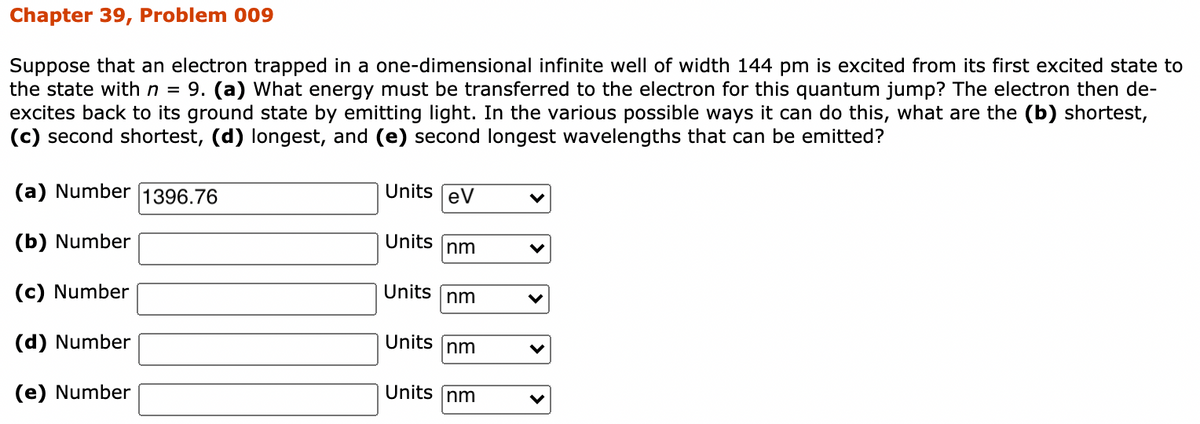Suppose that an electron trapped in a one-dimensional infinite well of width 144 pm is excited from its first excited state to the state with n = 9. (a) What energy must be transferred to the electron for this quantum jump? The electron then de- excites back to its ground state by emitting light. In the various possible ways it can do this, what are the (b) shortest, (c) second shortest, (d) longest, and (e) second longest wavelengths that can be emitted? Units eV (a) Number 1396.76 Units nm (b) Number Units nm (c) Number Units nm (d) Number Units nm (e) Number
Suppose that an electron trapped in a one-dimensional infinite well of width 144 pm is excited from its first excited state to the state with n = 9. (a) What energy must be transferred to the electron for this quantum jump? The electron then de- excites back to its ground state by emitting light. In the various possible ways it can do this, what are the (b) shortest, (c) second shortest, (d) longest, and (e) second longest wavelengths that can be emitted? Units eV (a) Number 1396.76 Units nm (b) Number Units nm (c) Number Units nm (d) Number Units nm (e) Number
Principles of Modern Chemistry
8th Edition
ISBN:9781305079113
Author:David W. Oxtoby, H. Pat Gillis, Laurie J. Butler
Publisher:David W. Oxtoby, H. Pat Gillis, Laurie J. Butler
Chapter4: Introduction To Quantum Mechanics
Section: Chapter Questions
Problem 39P: Chapter 3 introduced the concept of a double bond between carbon atoms, represented by C=C , with a...
Related questions
Question

Transcribed Image Text:Chapter 39, Problem 009
Suppose that an electron trapped in a one-dimensional infinite well of width 144 pm is excited from its first excited state to
the state with n
9. (a) What energy must be transferred to the electron for this quantum jump? The electron then de-
excites back to its ground state by emitting light. In the various possible ways it can do this, what are the (b) shortest,
(c) second shortest, (d) longest, and (e) second longest wavelengths that can be emitted?
(a) Number 1396.76
Units
eV
(b) Number
Units
nm
(c) Number
Units nm
(d) Number
Units nm
(e) Number
Units (nm
>
Expert Solution
This question has been solved!
Explore an expertly crafted, step-by-step solution for a thorough understanding of key concepts.
Step by step
Solved in 4 steps

Knowledge Booster
Learn more about
Need a deep-dive on the concept behind this application? Look no further. Learn more about this topic, chemistry and related others by exploring similar questions and additional content below.Recommended textbooks for you

Principles of Modern Chemistry
Chemistry
ISBN:
9781305079113
Author:
David W. Oxtoby, H. Pat Gillis, Laurie J. Butler
Publisher:
Cengage Learning

Physical Chemistry
Chemistry
ISBN:
9781133958437
Author:
Ball, David W. (david Warren), BAER, Tomas
Publisher:
Wadsworth Cengage Learning,

Chemistry: The Molecular Science
Chemistry
ISBN:
9781285199047
Author:
John W. Moore, Conrad L. Stanitski
Publisher:
Cengage Learning

Principles of Modern Chemistry
Chemistry
ISBN:
9781305079113
Author:
David W. Oxtoby, H. Pat Gillis, Laurie J. Butler
Publisher:
Cengage Learning

Physical Chemistry
Chemistry
ISBN:
9781133958437
Author:
Ball, David W. (david Warren), BAER, Tomas
Publisher:
Wadsworth Cengage Learning,

Chemistry: The Molecular Science
Chemistry
ISBN:
9781285199047
Author:
John W. Moore, Conrad L. Stanitski
Publisher:
Cengage Learning

Chemistry: Principles and Reactions
Chemistry
ISBN:
9781305079373
Author:
William L. Masterton, Cecile N. Hurley
Publisher:
Cengage Learning

Chemistry: Principles and Practice
Chemistry
ISBN:
9780534420123
Author:
Daniel L. Reger, Scott R. Goode, David W. Ball, Edward Mercer
Publisher:
Cengage Learning

Organic Chemistry: A Guided Inquiry
Chemistry
ISBN:
9780618974122
Author:
Andrei Straumanis
Publisher:
Cengage Learning